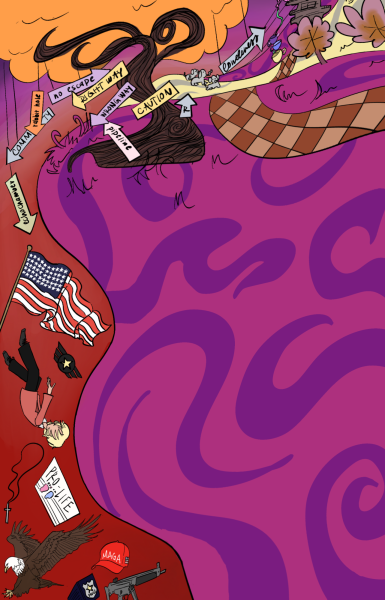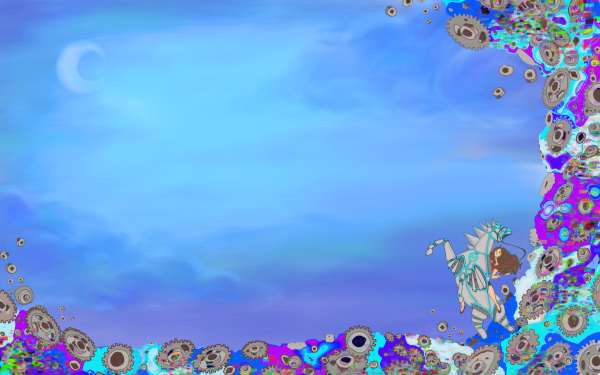Understanding trigger warnings
With the increased use of trigger warnings, concerns about effectivity, student well-being, and academic freedom arise.

Sophia* (class of ’22) had no idea what she was going to read about, over Zoom, within Chapter 13 of The Bell Jar. To her surprise, a detailed description unfolded of the main character attempting suicide through overdosing on painkillers. The scene narrated how the girl ‘faded’ away.
“One of my close friends had tried to commit suicide in this very specific manner,” Sophia said. “And it happened to be the exact manner that was described in the book. Hearing the narrator describe that, I was like, this is not something that I personally wanted to hear because I connected that to my friend.”
It was only after Sophia finished the section that she realized the damage it had done. If given the choice to go back, Sophia said, she would skip reading that portion.
“It was a very painful experience when [my friend’s suicide attempt] first happened,” Sophia said. “But, I was also getting a new, worse experience of it when I read the book since it was so vivid. There were things that I hadn’t even considered. I felt like I was re-experiencing that painful experience but worse. And I was also alone in my house, which was not my favorite.”
Sophia had friends in the class who were aware of the incident, allowing her to openly discuss her feelings with them.
“I’m lucky that I had friends in the class who knew that same person so that I wouldn’t have to deal with that alone,” Sophia said. “If I had to go through it alone, I think it would’ve been much worse.”
Prior to this Sophia said she had never given much thought to trigger warnings. She assumed they could be helpful, but she wasn’t sure if it would be too much of a burden on educators to provide them.
“After [reading The Bell Jar], I realized how strongly it can affect a person to read something that hits that deeply,” Sophia said. “For me, any trade-off with trigger warnings being cumbersome to provide is gained back from potentially preventing the student from having that emotionally stressful experience.”
The term ‘trigger warnings’ first originated in the late-1990s when they were primarily used as cautions to viewers about the presence of graphic rape descriptions. Long before then, psychologists had already begun identifying post-traumatic stress disorder [PTSD] ‘triggers.’
Payton Jones, a data scientist who graduated from Harvard University with a Ph.D. in experimental psychopathology, conducted research on trauma and trigger responses.
“Trigger warning originated as a grassroots thing,” Jones said. “They weren’t designed by psychologists as a sort of intervention. They arose naturally, which is why they weren’t tested for a long time. [Before we published a study in 2018,] it was unclear whether or not trigger warnings would work. For example, there are cases when people are prepared to receive a shock and it’s less painful than if you shock them unexpectedly. But there’s also reason to believe they might not be helpful, because if you tell someone a medication has side-effects, they’re more likely to actually experience those side-effects.”
For Calvin Kellenberger (12), the use of trigger warnings by peers in his writing seminar class has been beneficial.
“In class, we share a lot of intimate poetry at times,” Kellenberger said. “To their credit, people generally state that ‘this involves x and y’ before they start reading, which is good because there have been times where people need to step outside because they can’t listen to something on a particular day.”
One TV show his English class watched delved into toxic and one-sided relationships, topics that reminded Kellenberger of past experiences.
“I was extremely glad that there had been a little bit of a warning [before the show] because I was able to sit back and mentally prepare myself,” Kellenberger said. “I didn’t need to step out of the room, but the warning helped me put a little mental guard up so that I could just listen and think about the material without applying it to myself.”
Kellenberger said he believes that when students have personal experiences with certain topics, it’s appropriate to use trigger warnings.
“In my experience, the whole point of trigger warnings, essentially, is that if folks have trauma or something they’re able to avoid reliving in some capacity, they can go into [a lesson] knowing what to expect,” Kellenberger said. “For example, a minor who’s been sexually abused may not be able to handle discussing sexual abuse in ninth-grade sex-ed.”
Amna Khalid is an associate professor of history at Carleton College. She is a fellow at the University of California National Center for Free Speech and Civic Engagement and has written numerous articles regarding the impacts of trigger warnings.
Khalid said that the use of trigger warnings has significantly expanded, from originally being used for stimuli that could induce PTSD to material that can elicit any difficult emotional response.
Thus in a class discussion where there is no predetermined script, it can be more difficult to predict which material may or may not be triggering. Through his two decades of teaching, Psychology teacher Chris Fousek said he has learned how to pick up cues in class discussions when the material might require a warning for some students.
“I think it’s important for the classroom to be a safe space for students,” Fousek said. “It’s usually not my curriculum [that requires a trigger warning], but something that another student will say, and I’ve gotten better at recognizing when a line has been crossed.”

When students are uncomfortable with engaging with certain material, Fousek said he provides an alternative assessment. One such example in AP Psychology are the chapters about cults.
“In cults, there are some topics built into it, like coercion, mistreatment, and assault,” Fousek said. “Some of those things are part of a documentary we watch, so I definitely try to give a trigger warning before that. I have an alternative set of articles that can teach you about the psychological aspect of coercion and social psychology without getting into some of the graphic kinds of elements of it [for students who opt-out of watching the documentary].”
At the same time, though, academic content can often be uncomfortable, yet necessary to learn, Kellenberger said.
“I understand some people can be uncomfortable talking about historical events like the Holocaust, but that’s something we all need to learn about,” Kellenberger said. “It’s part of being aware of the world around you and the systems around you. So, I can completely understand wanting to avoid an unpleasant experience when someone already has personal knowledge, but there’s a difference between that and choosing to be ignorant or not wanting to learn about the topic at all.”
Although trigger warnings have never caused Fousek to shy away from uncomfortable or sensitive subjects in psychology, for many in academia, this has been the case. Ultimately, Khalid said that the use of trigger warnings can restrict academic freedom, particularly when faculty choose to avoid controversial topics altogether.
“[Some professors’] list of potentially triggering content that justify missing class include Nazi symbols, alcohol, profanity, slurs, and even the Emancipation Proclamation,” Khalid said. “This approach waters down meaningful engagement with important topics. In U.S. History courses, for example, you can’t present an accurate portrait of past events without covering horrifying material, from the genocide of native peoples to the tragedy of 9/11. If we truly want to understand and reckon with past and present atrocities, we must be willing to face difficult, and even excruciating moments.”
English teacher Nikolette Reigle has found that discussing books in an academic context, for some students, can be a safer space than exploring that subject on their own.
“I never force anyone to sit through a Socratic seminar or talk about [sensitive issues], but the reading and discussion of books can be a good way to talk about these issues and talk about these topics in a somewhat safe spot,” Reigle said. “You’re around some of your peers that you know, and it can be a good learning environment. It can be a way for students who haven’t experienced these things to hear from a character’s point of view.”
Throughout her time teaching, Reigle said that it has been very rare for a student to opt-out of reading a chapter or section of a book in her classes; only four to five students over the years have done so.
Sophia said that after going to college, taking advantage of trigger warnings has become more normalized. For example, some of her professors announce that students can choose to mentally tune-out or put earbuds in if they wish.
“Although it is important to encourage those students who actively avoid learning about certain topics to learn, I feel like it is sort of a trade-off that has to be made for the emotional well-being of other students,” Sophia said. “[For example,] if a student is really transphobic and doesn’t want to engage with the discussion of transphobia in a meaningful way, they probably wouldn’t be engaging anyway. So for me, it falls down to not wanting to cause emotional stress on a trans student who may have experienced that.”
Jones helped conduct various studies on the effects of trigger warnings. One such paper he published was a meta-analysis, or an examination of numerous studies on trigger warnings to determine their overall effect.
“The main thing that’s been looked at in these studies is response anxiety, which is when someone is given a trigger warning and then you show them the content, how do they react?” Jones said. “How anxious or upset are they? And most studies have found that trigger warnings make no difference [in that reaction]. A couple of studies have found that they increase anxiety, but overall, when you look at the statistics pooled, there’s no main effect.”
Studies have shown that a common purpose for using trigger warnings, their ability to help one mentally prepare themselves, also falls short. Scientists tested various trigger warnings on text, photos, and videos; the consensus was that they failed to help individuals brace themselves for sensitive content. Jones also looked at levels of avoidance. Overall, there was no notable difference in trauma survivors between avoidance for content with trigger warnings and without.
“In some studies, if you give people two choices, one that has a trigger warning and one that doesn’t, people actually click on the trigger warning one a little bit more,” Jones said. “That can actually increase engagement rather than increasing avoidance, but by and large, they make no difference.”
And according to the National Center for PTSD, “using avoidance as your main way of coping with traumatic memories can make PTSD symptoms worse.” However, research has shown that trigger warnings can cause anticipatory anxiety.
“Anticipatory anxiety is after you’ve given the trigger warning, but before you’ve shown someone the actual content,” Jones said. “In that waiting period, people are nervous, and in that sense, trigger warnings can cause more harm than benefits.”
Outside of an academic context, trigger warnings have also been increasingly utilized on social media. Over quarantine, Aadya Nayak (12) inadvertently ended up seeing graphic videos on Instagram. Such videos contained graphic depictions of police brutality, protests, and animal violence, among other scenes. One particular video was of someone committing suicide.
“Especially on Instagram, a lot of people are young, even younger than 13 sometimes,” Nayak said. “Clicking on a video and not knowing what it is and being assaulted with an image, I feel like is completely inappropriate. People were even sending around a video [of someone being shot] with a picture of video games over it, so it looked like something else. You would click on it, and you saw someone dying on screen. That’s when I really felt like we needed trigger warnings. We need it to be blurred so people don’t have to see things they did not consent to see.”
Kellenberger, too, was often confronted with graphic clips, particularly of police brutality, on Instagram during 2020.
“A lot of friends of mine, who are people of color, talked about how they don’t want to go on Instagram and see someone like them get shot again,” Kellenberger said. “When I watched those clips, I was like ‘Oh god this is horrifying. We need to do something about this.’ I can understand though, for people of color particularly, who are like ‘This has been a problem. We knew it was a problem. You’re just seeing it now. I don’t want to see it all day.’ Those people don’t need more media exposure to understand what’s going on. I did.”
Mevagh Sanson is a post-doctoral research fellow in psychology at the University of Waterloo. Her research explored whether or not trigger warnings could alleviate symptoms of distress. She found that people with a history of trauma reported similar levels of avoidance and intrusion regardless of whether they received a trigger warning. Like Khalid and Jones, Sanson is hesitant on using trigger warnings in a classroom setting.
“A history teacher might decide that it is important for students to learn about the Holocaust as part of learning about World War 2,” Sanson said. “In that case, it would be normal for students to feel upset hearing about the Holocaust because it was an awful event. In other words, feeling negative emotions is a normal part of being human; it doesn’t necessarily cause harm or suggest mental health problems.”
At the end of the day, Kellenberger said he believes that striking a balance is critical.
“Someone being uncomfortable with something may give them the right to excuse themselves from having to listen to a topic, but it doesn’t give them the right to excuse everyone else from having to listen to it,” Kellenberger said. “There needs to be a balance between student comfort and the teacher’s ability to teach.”
*Names changed






